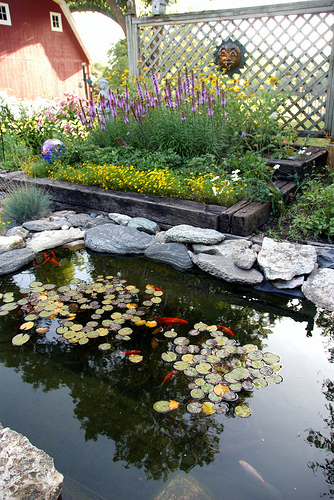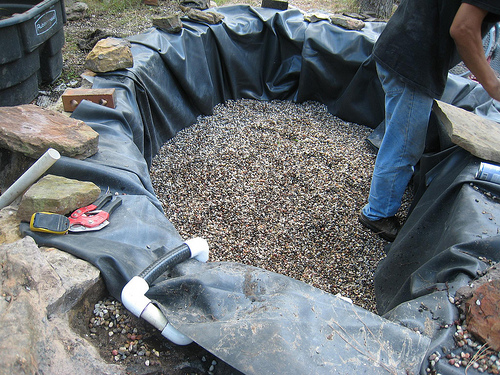In the wintertime, thinking about your backyard can be the last thing on your mind. Yet, it’s at the beginning of the year that you’re planning out your home improvement budgets, which just as often include adding value to your landscaping plan. One way to spruce up your backyard spaces is by adding an in-ground water feature, or even a pond with live fish.
But, where do you get started on a project like that? Landscaping, and pond installation expert Craig Goddard is ready to explain some of the basic principles of incorporating an in-ground water feature to your outdoor spaces.
***
So, you want an in-ground water feature.
First, ask yourself what type of in-ground water feature or pond you would like or need. Do you want a shallow one to become a haven for wildlife, require less maintenance and fit in with a meadow style garden? Perhaps you want a specialist fish pond for keeping Koi in the best position possible? Choose the type you want bearing in mind how much time and budget you can give to building and maintaining it.
Also decide if you will want a water feature. If you want a fountain or waterfall you will need to plan where the electrics will run and the drainage. You will need a skimmer to take water from the pond using a pond pump system to take it back to the start of the system.
Will you need something to stop the pond from freezing in winter? Fountains and waterfalls may do this or you can install a water pump or heater.
Landscaping a water feature – think about placement
You must then choose the correct location for your pond to create the right conditions for wildlife and fish. Don’t put it in the sunniest spot in your garden or you’ll find it fills with algae easily. By the same token don’t put it entirely in the shade. Keep away from trees where roots may lie underground and leaves would fall into the pond often. If you would like a deep pond to keep fish in, check where your utility pipes run and to avoid causing damage to them.
Choosing in-ground water feature sizes
Look at your garden and imagine the way the feature will look in it. Mark out the size you would like and stand back to take it in. Does it overpower the garden and dominate? Is it big enough for the amount of fish you wish to keep? You can consult resources about the species of fish you wish to keep to find out the optimum size for them.
When it comes to depth, fish require from around 70cm, but check with the experts about specific species. For example, Koi require 100cm depth to survive in the typical temperate zone winter.
Water feature shapes are best kept simple
When you have made your decisions and plans you are ready to get creating. Measure and plan it out before you start digging and mark out the outline. Although you may want to put in curves to give it that ‘natural’ look, try to keep it simple as these will add to your work later on when creating shelves and lining your it.
How to dig a pond or water feature
OK, start digging! Don’t overdo it though, especially if you are going for a shallower type in order to attract wildlife. Create gentle slopes from the edges so small creatures can move around and shallow-loving plants can thrive. If you are going for the natural look you need only go a few centimetres below the soil level ensuring you slope down to the deepest point.
When creating a fish pond don’t make the entire area 100cm deep. Make a section that depth then slope up to a shelf and repeat creating two or three shelves. Remember to allow for your sand layer and liners, so dig a little deeper than necessary.
In-ground water feature pond liners
When you have finished digging, remove any large rocks or sharp objects and put down a layer of sand. Now you are ready to lay your underlay and liner. At his point you might wonder why both are relevant, but underlay is essential for protecting your liner from being pierced and your entire work ending up from leaking.
Place your underlay over the pond and push down into the shape. You can either cut around the edges with the liner in the basin, or mark it out and bring back out to cut on the flat. Be sure to leave a few more centimetres than you need at the edges to account for when the water is in it and any lumps and bumps. Lay this and secure it round the edges with paving slabs or rocks.
Repeat the process for the lining and secure it all with a few paving slabs placed on the bottom.
Filling an in-ground water feature
Shallow wildlife ponds can be left at this point to fill up over time with rainwater. However if its too deep or you would prefer to fill it with the garden hose then that’s perfectly normal practice. When filling it up it’s a good time to check that the liner fits properly.
Don’t fill it up to the level of the surrounding dirt or turf as you must allow for any plants or fish you will introduce, as well as rainfall. When it is full cut off any excess liner.
Balance and harmony
To create the right conditions for life you must make sure the chemical and PH balance of the water is correct. Plants work to restore the balance but initially you will need to use chemical mixes and/or pond bacteria to remove any harmful substances from the tap water you fill up with.
Keep it up
In order to maintain it all you will need to test the water quality, remove leaves and debris, and clean the filter (if you have one) at regular intervals. If you have a fish pond you need to ensure you do not over feed your fish and keep an eye on their numbers and size to ensure they are getting enough oxygen.
There are many guides available to help you maintain your garden water feature. You can add in plenty of extra features once you get going, you can even add in Pond lights that will create a unique look and a great feature in your garden.
***
Thanks, Craig!
Craig writes articles about landscaping and pond installation on behalf of Pondkeeper.co.uk.
Cheers!
Rob.



